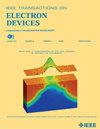Floating Island Structure With Metal Bridge to Resolve the Turn-On Recovery Problem
IF 2.9
2区 工程技术
Q2 ENGINEERING, ELECTRICAL & ELECTRONIC
引用次数: 0
Abstract
The floating Island (FI) device has a severe turn-on recovery problem. In this brief, a new “metal bridge” that connects the Island and the N+ buffer through ohmic contact is proposed. The objective of the new structure is to resolve the turn-on recovery problem. Simulations are conducted to validate the efficacy of the structure. The proposed FI junction barrier Schottky with the proposed metal bridge (MB-FIJBS) shows no voltage overshoot and has significantly reduced the recovered on-state voltage compared to the conventional junction barrier Schottky (Conv. JBS). The recovered on-state voltage of the MB-FIJBS is the same as its static On-state voltage, proving a complete recovery. The mechanism of the turn-on process of the MB-FIJBS is elucidated. The MB-FIJBS achieves rapid recovery by completely removing any additional potential barrier in the current flow path. The MB-FIJBS is well designed, so that it does not degrade the breakdown voltage (BV). The 3-D implementation of the MB-FIJBS is proposed to provide a practically feasible structure that is compatible with the current manufacturing process. A simulation of the 3-D structure has been conducted to validate its effectiveness.带金属桥的浮岛结构可解决转向回收问题
浮岛(FI)器件存在严重的开启恢复问题。本文提出了一种新的 "金属桥",通过欧姆接触连接浮岛和 N+ 缓冲器。新结构的目标是解决开启恢复问题。我们通过仿真验证了该结构的功效。与传统的肖特基结势垒(Conv. JBS)相比,带有金属桥的拟议 FI 结势垒肖特基(MB-FIJBS)没有出现电压过冲,并显著降低了恢复的导通电压。MB-FIJBS 的恢复导通电压与其静态导通电压相同,证明其完全恢复。研究还阐明了 MB-FIJBS 的导通机制。MB-FIJBS 通过完全消除电流路径中的任何附加势垒实现快速恢复。MB-FIJBS 经过精心设计,不会降低击穿电压 (BV)。我们提出了 MB-FIJBS 的三维实施方案,以提供与当前制造工艺兼容的实际可行结构。对三维结构进行了模拟,以验证其有效性。
本文章由计算机程序翻译,如有差异,请以英文原文为准。
求助全文
约1分钟内获得全文
求助全文
来源期刊

IEEE Transactions on Electron Devices
工程技术-工程:电子与电气
CiteScore
5.80
自引率
16.10%
发文量
937
审稿时长
3.8 months
期刊介绍:
IEEE Transactions on Electron Devices publishes original and significant contributions relating to the theory, modeling, design, performance and reliability of electron and ion integrated circuit devices and interconnects, involving insulators, metals, organic materials, micro-plasmas, semiconductors, quantum-effect structures, vacuum devices, and emerging materials with applications in bioelectronics, biomedical electronics, computation, communications, displays, microelectromechanics, imaging, micro-actuators, nanoelectronics, optoelectronics, photovoltaics, power ICs and micro-sensors. Tutorial and review papers on these subjects are also published and occasional special issues appear to present a collection of papers which treat particular areas in more depth and breadth.
 求助内容:
求助内容: 应助结果提醒方式:
应助结果提醒方式:


